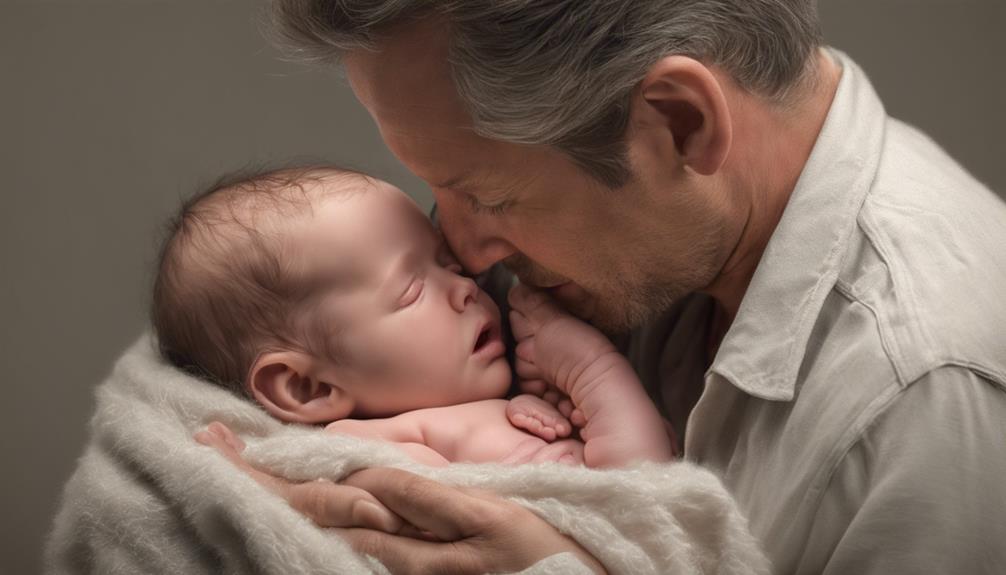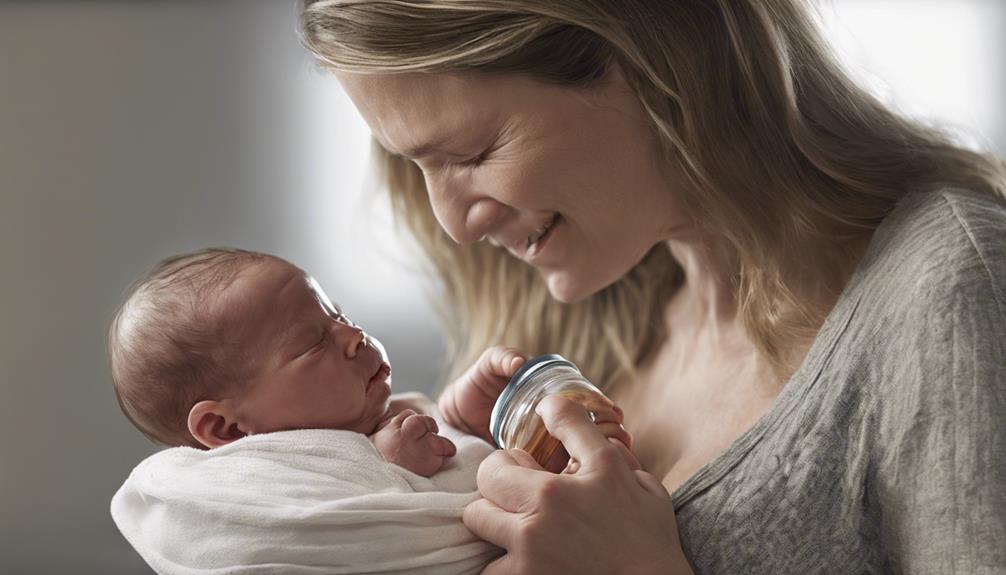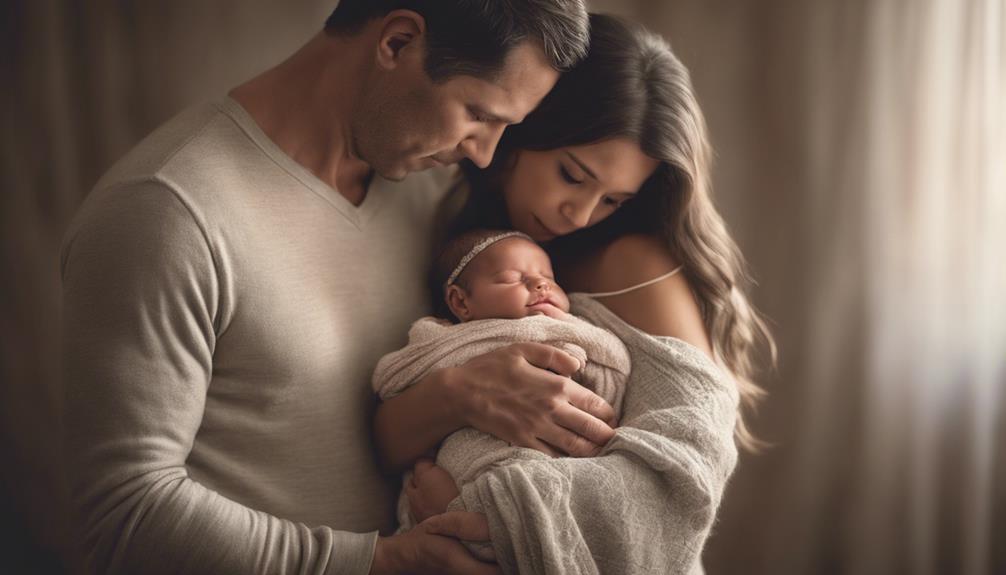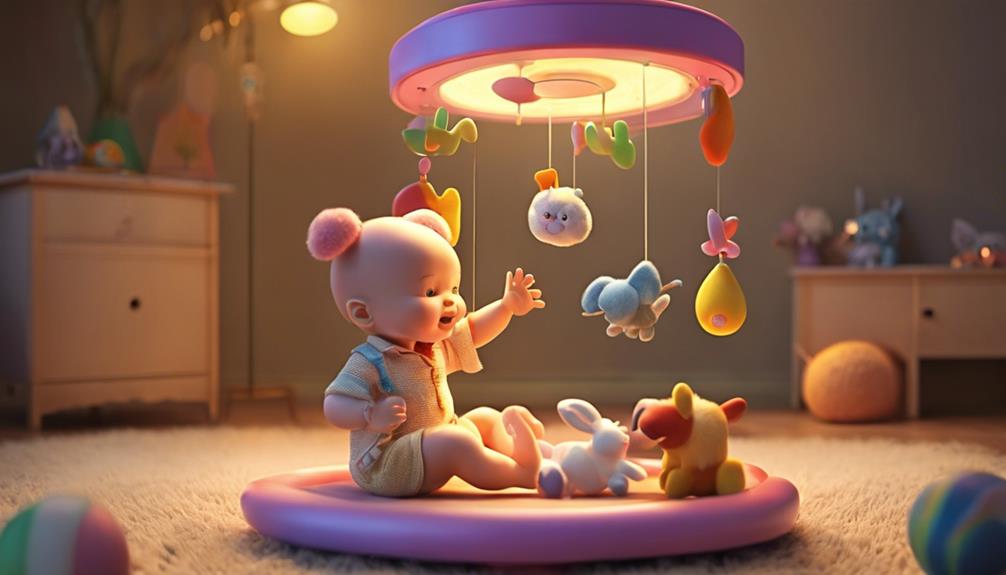Imagine your newborn's tiny chest rising and falling with each hiccup, a sight that can tug at your heartstrings. But fret not, as there are seven quick ways to ease these pesky hiccups and bring comfort to your little bundle of joy.
From simple techniques like swaddling and using a pacifier to more practical methods such as burping and changing positions, these tips can help alleviate your baby's discomfort swiftly. However, there's one important factor to take into account that might just surprise you.
Key Takeaways
- Swaddle snugly, use a pacifier, and burp properly to ease newborn hiccups.
- Create a calming environment with gentle movements and feeding adjustments.
- Seek medical advice if hiccups persist despite soothing techniques.
- Consider natural remedies and consult a pediatrician for effective hiccups relief.
Swaddling
To help soothe your newborn baby's hiccups effectively, consider swaddling them snugly yet comfortably to create a womb-like environment that promotes relaxation and reduces the likelihood of hiccups. Swaddling your little one can mimic the feeling of being in the womb, providing a sense of security and calmness that can help alleviate hiccups. This technique also helps prevent the startle reflex, which might trigger hiccups in newborns.
When swaddling your baby, it's important to make sure you're using the proper technique. Wrap your baby snugly but make sure that their hips and legs have enough room to move freely. This balance between being securely wrapped and allowing some freedom of movement is essential. Remember not to swaddle too tightly, as this can restrict breathing and overall comfort. Creating a cozy and snug environment through swaddling can aid in relaxation and provide comfort to your newborn, helping to ease those pesky hiccups.
Pacifier
If your newborn is hiccuping and you're looking for a quick solution, consider offering a pacifier.
Pacifiers can help relax your baby's diaphragm and provide comfort by mimicking the sucking reflex.
Using a pacifier is a safe and simple way to potentially stop hiccups and soothe your little one.
Pacifier Benefits Explained
When soothing your newborn's hiccups, consider the benefits of using a pacifier to help relax their diaphragm and promote calmness.
- Pacifiers can relax the diaphragm, potentially stopping newborn hiccups.
- The sucking motion on a pacifier can calm and soothe babies, aiding in resolving hiccups.
- Pacifiers are a safe option to try for managing and alleviating baby hiccups.
Using a pacifier is a non-invasive method that can address hiccups without potential side effects. Additionally, pacifiers provide comfort and distraction for babies experiencing hiccups, offering a gentle way to help your little one feel better.
Proper Pacifier Usage
Consider how properly using a pacifier can effectively relax your newborn's diaphragm and help alleviate hiccups with gentle ease.
Pacifiers mimic the sucking reflex, which can soothe the diaphragm and reduce hiccups without causing any distress.
It's important to select a pacifier of safe size and shape suitable for your baby's age to prevent choking hazards.
Using a pacifier after feedings can offer comfort and may effectively alleviate hiccups.
Pacifier Safety Tips
To guarantee your baby's safety and comfort, prioritize selecting a one-piece pacifier with ventilation holes for best pacifier safety. Here are some essential pacifier safety tips to keep in mind:
- Choose Wisely: Opt for a one-piece pacifier with ventilation holes to prevent moisture buildup and reduce the risk of skin irritation.
- Inspect Regularly: Check the pacifier frequently for signs of wear and tear to make certain it remains safe for your baby to use.
- Follow Guidelines: Adhere to the manufacturer's guidelines for age-appropriate sizes and shapes to guarantee safe pacifier usage.
These simple steps can help you provide a secure and soothing experience for your little one while using a pacifier.
Burping

Burping your newborn baby gently after feedings is an essential way to release trapped air in their stomach, helping to prevent hiccups. By using proper burping techniques, such as holding your baby against your chest and gently patting or rubbing their back, you can effectively release any trapped air that may cause discomfort.
Remember to burp your baby during and after feedings to reduce the chances of excessive air swallowing, which can lead to hiccups. Not only does burping help with hiccups, but it can also alleviate discomfort from gas and reflux, making your baby happier and more content.
Regular burping sessions should become a routine part of caring for your newborn, as they can be a simple yet effective way to soothe your baby and prevent hiccups. By incorporating burping into your feeding routine, you can help your baby stay comfortable and minimize the chances of hiccups interrupting their day.
Feeding Techniques

Implementing proper feeding techniques is essential for reducing the likelihood of your newborn experiencing hiccups. To help prevent hiccups during feeding sessions, consider the following tips:
- Burp Your Baby: Remember to burp your newborn both during and after feedings. This practice can release any trapped air in the stomach, decreasing the chances of hiccups.
- Use a Slower-Flow Nipple: When bottle feeding, opt for a slower-flow nipple. This can help prevent your baby from swallowing air too quickly, which is a common trigger for hiccups.
- Hold Your Baby Upright: After each feeding, hold your baby upright for about 20-30 minutes. This position aids in digestion and reduces the likelihood of hiccups occurring.
Changing Positions

When soothing your newborn's hiccups, consider adjusting their position to ease pressure on the diaphragm and assist in alleviating discomfort. Changing positions from lying down to upright can help relieve hiccups by allowing trapped air to escape more easily. Placing your baby in an upright position or holding them against your shoulder can aid in stopping hiccups. Supporting your baby's head and neck during position changes is essential to prevent any discomfort. You can also try gently patting or rubbing your baby's back while they are in an upright position to help release trapped air causing the hiccups. Experimenting with different positions like gentle rocking or allowing your baby to rest on your chest can provide relief from hiccups. The table below illustrates some effective positions and actions to help soothe your newborn's hiccups:
| Position | Action |
|---|---|
| Upright Position | Patting back gently |
| Seated Position | Rubbing back softly |
| Holding Against Shoulder | Supporting head and neck |
Gentle Patting

To help alleviate your newborn's hiccups, gently patting their back can effectively release trapped air bubbles and provide relief. Here's how gentle patting can help soothe your baby's hiccups:
- Release Trapped Air Bubbles: By softly patting your baby's back, you can assist in releasing any trapped air bubbles that might be causing the hiccups.
- Relax the Diaphragm: Patting your baby in an upright position can help relax the diaphragm, potentially stopping the hiccups in their tracks.
- Stimulate Burping and Alleviate Hiccups: Applying gentle pressure while patting can stimulate burping, aiding in alleviating the hiccups your baby is experiencing.
Consistent and rhythmic patting motions not only provide comfort to your little one but also play an essential role in resolving hiccups. Remember, a few minutes of gentle patting after feeding can be an effective way to soothe your baby and calm those pesky hiccups.
Distraction

Consider engaging your newborn in gentle rocking or playing a soothing lullaby to divert their attention from the hiccups they're experiencing.
Distraction techniques can be incredibly effective in helping your baby cope with hiccups. Offering a favorite toy or introducing a calming sound can shift their focus away from the discomfort of hiccups.
You may also try gentle baby massage or soft pats on the back to redirect their attention and potentially ease the hiccups.
Creating a serene environment by dimming lights or swaddling your baby snugly can help them relax and reduce the hiccuping sensation.
Additionally, encouraging gentle swaying or walking with your baby provides comforting and rhythmic movements that may aid in stopping the hiccups.
Frequently Asked Questions
Is It OK to Lay My Newborn Down With Hiccups?
Yes, it's perfectly safe to lay your newborn down with hiccups. Hiccups are common and harmless in newborns. They won't worsen from lying down. Your baby can sleep comfortably with hiccups, as they don't affect their rest.
What Is the Best Position for Baby Hiccups?
When your baby hiccups, cradle them upright against your chest. This gentle position helps release trapped air, easing those tiny hiccups. Support their head and neck with care, giving relief after feeding for a comfortable spell.
Do Hiccups Mean Baby Is Full?
Hiccups in newborns don't necessarily mean they're full. They're a normal part of digestion, often caused by swallowing air during feedings. Whether hungry or not, babies can hiccup. It's a common, harmless occurrence unrelated to their feeding status.
What Stops Hiccups Quickly?
Wondering what stops hiccups quickly? Burping, offering a pacifier, changing positions, and gentle back rubs can help soothe your newborn's hiccups fast. Remember, proper feeding and avoiding overfeeding can prevent hiccups in the first place.
Conclusion
To summarize, when your precious little one experiences those adorable hiccups, remember to try these gentle soothing techniques. By swaddling, using a pacifier, and practicing burping, you can help ease their discomfort.
Changing positions, gentle patting, and providing distractions can also make a difference. Rest assured, with these tips, you'll be well-equipped to handle those cute hiccups with ease and comfort for your newborn.










